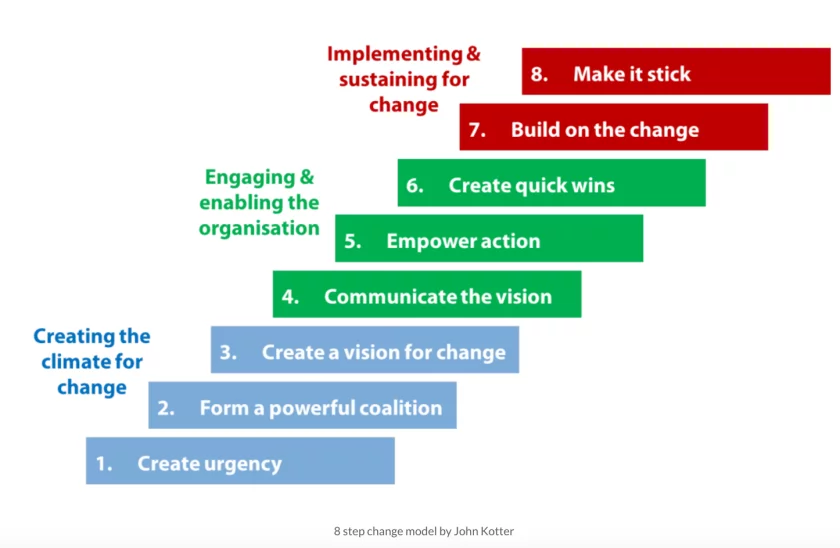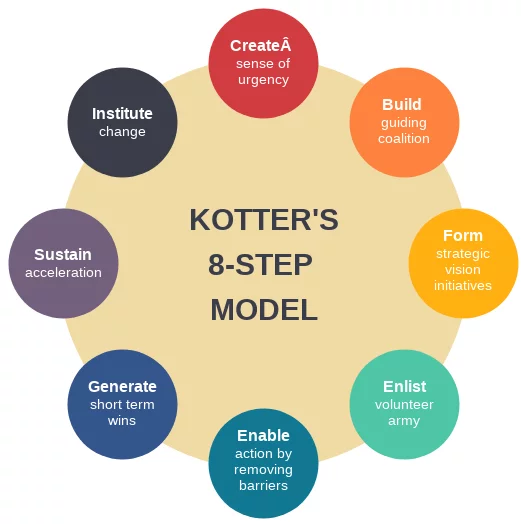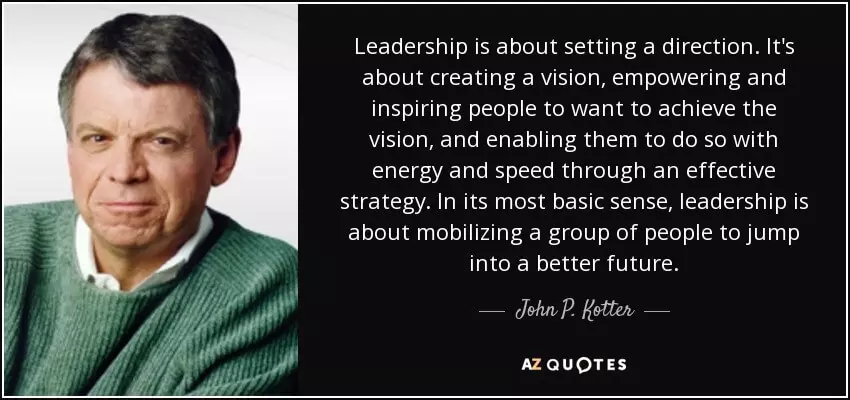The 8-step Kotter change model refers to a change management framework developed by Dr. John Kotter, one of the world’s foremost experts on organizational change management.
Like Prosci’s ADKAR model, Kotter’s 8-step model has been used by industries around the world to power change, overcome obstacles, and improve the outcomes of business transformation programs.
Let’s look at this model in depth and explore how it can be leveraged to drive change in your organization.
The 8-step Kotter Change Model: A breakdown
Organizational change has become necessary for many companies in today’s fast-moving economy.
Factors such as digital disruption, shifts in the competitive landscape, and evolving customer expectations often compel businesses to invest in business change programs. Yet managing that change is rarely easy, and poor management can lead to equally poor outcomes, high costs, employee resistance, and other problems.
Models such as the John Kotter’s change model are designed to avoid or mitigate such issues, by focusing on change at the level of the employee.

Employees are the ones actually implementing change programs, after all. Success depends on their abilities, their engagement, and their support.
Here are eight steps that managers can use to earn that support and propel change forward:
1. Create a sense of urgency
To engage employees and earn their support, they must actually feel its importance, both with their hearts as well as their heads.
By concentrating on a “window of opportunity” that will close soon, it will be easier to align and direct employees toward a common goal.
2. Build a guiding coalition
A cross-functional team drawn from different levels of the organization will offer new perspectives and ideas.
Their guidance will be instrumental in leading the change, so it is important to choose a team that is committed to the current change program.
3. Form a strategic vision and initiatives
Among other things, a strategic vision should be communicable, desirable, flexible, and imaginable.
Qualities such as those reinforce the idea presented in the first step – to motivate people, it is important to appeal to their hearts as well as their minds.

4. Enlist a volunteer army
A large number of employees will be needed to implement large-scale change.
The term “volunteer” is key here. Employees should be given a choice in the matter and, when they are compelled by a strong enough vision, they will actually want to drive change, rather than feel like they have to.
5. Enable action by removing barriers
Existing barriers, such as old business processes or habits, can easily impede progress.
Though it may seem self-evident, progress cannot be made until these are identified and proactively removed. If they are not deliberately tackled, they may become problematic later on.
6. Generate short-term wins
Data should be collected that demonstrates accomplishments, big or small, then those results should be communicated to teams.
Meaningful wins will be those that people care about, and tangible wins can be replicated and scaled.
7. Sustain acceleration
Progress should be pushed after the first win, since lost momentum can be difficult to regain.
By continuing to remind teams of the urgency and expanding the volunteer army, managers can ensure that the program does not stall or slow.
8. Institute change
New systems and processes are as easy to lose as a project’s momentum, which is why they must be reinforced.
Even after the project’s completion date, it is important to revisit changes and ensure that they are repeated.
Takeaways and lessons from the Kotter Model

The Kotter model not only offers an understandable and practical framework for managing change, it also reveals very useful business principles that can be applied during change efforts:
Emotions are as important – if not more important – than logic. Repeatedly, the Kotter model emphasizes the need to engage heads as well as hearts. A sense of urgency, for instance, grips people at an emotional level, which is much more likely to compel action than merely an intellectual understanding of the project’s purpose.
Management and leadership are both crucial to success. Leadership and management are both pivotal for an initiative to make progress. As the steps above demonstrated, change coordinators must design a project, while also closely managing and monitoring its activities. But progress will not be made unless someone also actively leads the program by, for example, creating a strong vision and pushing programs forward if they threaten to stall.
Persistent, sustained effort is a must. Organizational change must be continually driven forward by committed leaders and team members. Steps such as generating short-term wins and sustaining acceleration (7 and 8), show the need for unflagging effort in order to see a project through to completion.
These lessons are vitally important for the success of any change program, and they highlight perhaps the most central area to focus on in change management: people.
This remains true even in today’s digital world, where adaptability and the ability to change are often a prerequisite for success.
Using the Kotter Model to drive change in the digital world
The above steps were taken from Kotter’s 2014 version of his earlier model, Leading Change.
Though both the earlier version and the latest version of his model are equally useful, he points out that they are useful in different contexts.
For companies that want to lead accelerated change programs, the model covered here is the most relevant. The steps are designed to be run concurrently and can be implemented quickly in a variety of business contexts, from traditional hierarchies to the digital workplace.
However, despite the model’s strengths, it may need to be augmented in order to drive digital change projects, such as digital transformation.
Namely, the Kotter model lacks an emphasis on training and skills development.
The Prosci change model, in contrast, focuses two of its five steps on training: providing employees with the knowledge they need to change and giving them the opportunity to demonstrate their abilities.
Since digital transformation relies so heavily on digital skills and savviness, training is an absolute must.
Digital adoption platforms (DAPs) such as the WalkMe platform can significantly improve the outcomes of a digital change effort, since they are designed to:
Onboard new users. Contextualized guidance helps employees decode and learn new software, a necessary step when companies adopt new tools.
Provide in-app training. Software walkthroughs take users one step at a time through a series of tasks, training them on new skills at their own pace.
Boost software engagement, proficiency, and productivity. Ultimately, using a DAP can positively impact a change project’s most important metrics, including its overall outcomes.
In conjunction with a strong change management model, features such as these can offer major benefits to the modern change manager.


